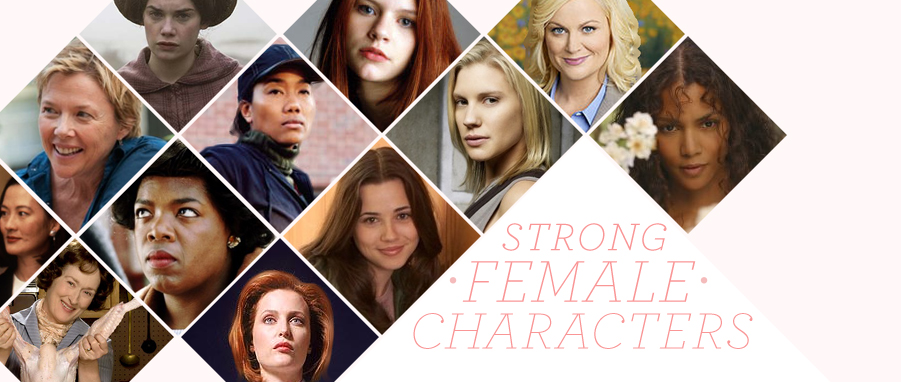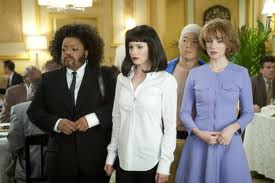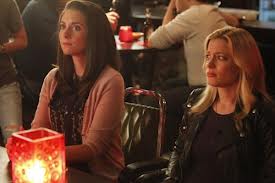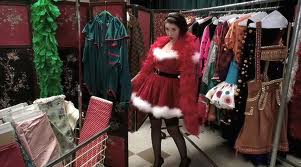With regards to “Community” fandom (and fashion, if you're Heidi Klum), you’re either in or you’re out. If you’re not a fan of the show, or haven’t watched it, you don’t understand what all the fuss is about. But if you are a fan, like me, then you won’t shut up about it. For those of you on the outside, “Community” is a manic, endearing, and ultimately brilliant half-hour comedy on NBC, soon to enter its fourth season. The plot centers on a group of misfit friends whose only commonality is that they attend Greendale Community College, where they regularly meet in a study group that doesn’t seem to consist of actual studying. Instead, crazy hijinks ensue! It’s produced some of the most ambitious episodes to hit prime time in years, including an entirely stop-motion Christmas episode (reminiscent of the old “Rudolph” style TV specials) and a 30-minute homage to the obscure 1980s film My Dinner with Andre.
It’s hard to describe exactly what it is “Community” does—genre send-ups, surrealist humor, endless pop culture references for the 20- to 40-year-old set—but whatever it is, it’s groundbreaking. And a large part of the credit is owed to the women who work on the show.
Creator Dan Harmon, at the recommendation of a female NBC studio head, made sure that his writing staff was comprised of half women. In an interview with the AV Club, he notes the difficulty he had in finding talented women writers—not because women aren’t talented, but because there just aren’t as many women writers to choose from—but that now he wouldn’t trade the gender makeup for the world.
Harmon: “The energy is different. It doesn’t keep anybody polite. We’re not doffing our caps or standing up when they enter the room. They do more dick jokes than anybody, because they’ve had to survive, they have to prove, coming in the door, that they’re not dainty. That’s not fair, but women writers, they acquire the muscle of going blue fast because they have to counter the stigma. I don’t have enough control groups to compare it to, but there’s just something nice about feeling like your writers’ room represents your ensemble a little more accurately, represents the way the world turns.”
Credit is also owed to the amazing cast, which notably includes three incredibly talented and hilarious women: Alison Brie (Annie), Yvette Nicole Brown (Shirley), and Gillian Jacobs (Britta).
Through the combined efforts of the writers and the actresses, the three female leads on the show are fleshed-out, complex, entirely human characters. Their personas are not entirely defined in relation to a more prominent male character. They aren’t wives, or love interests, or sidekicks. Despite the ostensible central lead of the show existing in Joel McHale’s egocentric ex-lawyer Jeff Winger, there’s a near-equal weight of importance given to each of the show’s seven main characters, and the women are just as interesting and well-explored as the men, if not more so.
In a totally engaging and lovely round-table interview with the Daily Beast, the “women of Community”—the three actresses plus writer Megan Ganz—dished on what made their show’s treatment of women special. This includes the, ahem, liberated sexuality of Gillian Jacobs’ character Britta. “The thing that is unique about [Britta] is that she is never the subject of slut shaming,” says Jacobs. “Like, she’s one of the only female characters that doesn’t ever get punished for having an active sex life.”
The sexuality of the women—most notably Brie and Jacobs, who are young and, by most people’s standards, hot—is an especially interesting point, when considering the use of sexuality as the defining spectrum for so many less-developed female characters on TV. It’s the age-old Mary Magdalene vs. Eve, slut vs. prude binary, which “Community” so successfully subverts. Jacobs goes on to note that when auditioning for high school characters in the past, she was dismayed at the way their representation was filtered and distorted through the male perspective—high school girls as seductresses, confident sex mavens; Ganz adds that these male writers often “remove all awkwardness from the teen experience.” The more complex and realistic sexuality of a character like Britta, and even the more subtle sexual evolution of a character like Annie, is refreshing in a landscape of women-as-seen-by-men.
There’s no real black-and-white, right-and-wrong guide to how a woman should portray her own sexuality. As with most things, the more agency she has in the process, the better, whether she chooses to show a lot or a little (so to speak). However, I have to admit I was taken aback to see this 2011 GQ feature of Brie and Jacobs, including a crazy suggestive photograph of the actresses in barely-there lingerie portraying a porn-worthy lesbian sex scene. As beautiful as they are, and as much agency as they may have had in creating this photograph, there’s still a real “ew” factor when imagining the relationship of this piece to the audience it’s intended for. You know—men’s magazine readers.
Not that overt sexuality is bad. To illustrate my point: take this scene in “Community” where Annie sings a sexy, wide-eyed, Betty-Boop-meets-Eartha-Kitt Christmas song, in what Ganz calls a send-up of the infantilization of female sexuality. It’s hilarious, and it showcases Annie’s sexiness without being exploitative—instead, with the song’s gradual devolution into nonsense words and floor-crawling, it becomes a self-aware critique of exploitation.
I suppose part of my discomfort with the photo shoot stems from the very different tone of the two scenes, and maybe specifically from the audience each one is intended for. Art isn’t created in a vacuum—there tends to be a dialectic between the creator and the audience out of which emerges the dominant interpretation of the work. Brie and Jacobs playing sexy on “Community” to an audience of viewers (mostly) in on the joke—and (mostly) appreciative of the very real comedic and performing talents of the two—feels legitimate, like there’s an end to the venture. Brie and Jacobs playing sexy on the pages of Gentlemen’s Quarterly, within whose audience the aforementioned criteria don’t exist, within whose pages instead women are regularly set on display as object of desire and/or decoration, feels exploitative. It’s sex for sex’s sake—women as fantasy creatures. Brie and Jacobs cease to be.
I’m in no way condemning Brie and Jacobs for this editorial choice-- nor for any other "sexy" photo shoots they choose to be a part of. They’re both absolutely fantastic and, in many ways, trailblazers. It's simply instructive that in our media, even wonderfully intelligent, forward-thinking, self-aware actresses such as these are inevitably represented in the visual language of a culture obsessed with sex and, particularly, women as sex objects-- and that there's a fine, often indistinguishable line between satirical and actual objectification.




